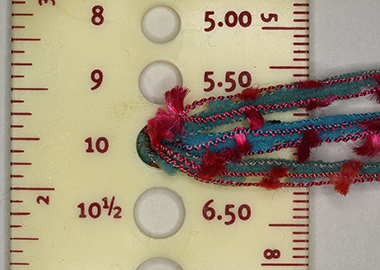Birds of a Feather Exhibit
Marcy Petrini
February, 2017
At the December meeting of the Chimneyville Weavers and Spinners Guild, the inspiration for our 2017 show was announced: “Birds of a Feather”. Our Guild member (and Craftsmen’s Guild of Mississippi president) Sharon Williams will mount the exhibit on March 1, so I didn’t have much time to plan and execute a project.
Luckily, birds are very colorful, so it’s not hard to match bird to yarn – or finished product to a bird!
A triangular shawl that I knitted with handspun late last year is going to the show; I had taken all yarns of silk and wools, other animal fibers and bamboo that I had been spinning and knitted them together. I was unsure how large of a piece the yarn I had would make. I could have knitted a sample and made the appropriate measurements, but I chose to improvise. I knew I had enough to make a shawl, I just didn’t know how big. In such cases, I make a triangular shawl, starting at the bottom and knitting up until I run out of yarn.
The needle size should be approximately 3 times the grist of the yarn. To figure it out, then, I take 3 strands of yarn and using a knitting needle gauge, I find the hole into which the 3 strands fit comfortably, not too tight, but not too lose. In the example below, using a commercial yarn, three strands fit into the size 10 needle hole. This is a good place to start.

For this project, there were yarns that were thicker than others. I decided to alternate two rows of the thicker and two rows of the thinner yarns; as I ran out of one yarn, I substituted a similar one. That way the transition in yarn color is pretty gradual. For yarns that were thinner yet, I used two strands together.
To knit, I start with one loop, then I knit in the front and back (Kf&b) of the loop so I have two stitches. For the third row, I knit 1, and Kf&b in the 2nd stitch. Now there are three stitches. From that point on, I knit 1, Kf&b, then knit to the end. Thus I increase one stitch at the beginning of every row to make the triangle.
The combination of the colors in each yarn, the colors of the alternating yarns, the colors of the yarns as they are substituted makes for a very bird-like appearance, I think.
The colors in birds’ feathers are not all pigments, but are structural coloration; that is, there is interference of the wave lengths of light as they bounce off the microscopic structures of the feathers. Did you ever see a rainbow on the surface of an oil patch after a rain? Then you have seen wave interference. You know those colors weren’t in the oil.
Since I knit until I run out of yarn, I have to make sure that I have enough to cast off. Toward the end, I measure a length of yarn that is 4 to 5 times the width of the piece and mark it, and then I make sure that I don’t knit past the marker. That rule of thumb works well for large size needles – I was using 11; for smaller needles, 3 to 4 times the width is sufficient.
Here is the shawl. It will be exhibited at the George Berry Gallery at the Mississippi Craft Center. Does it remind you of a bird?

Please email comments and questions to This email address is being protected from spambots. You need JavaScript enabled to view it..